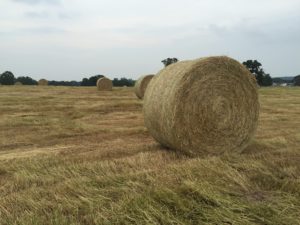Annual Ryegrass…a cool season annual forage often utilized by livestock producers for winter grazing. However, it’s often deemed an enemy of many a hay producer in East Texas. Volunteer annual ryegrass can be common in hay meadows. Winter rainfalls can promote seed germination and seeds can survive for multiple years in our soils. Later maturity of annual ryegrass can delay or prevent our warm season perennial forages (i.e. bermudagrass or bahiagrass) from breaking dormancy in April/May therefore delaying our initial hay cutting.
So how do we manage this unwanted ryegrass? We have several options:
- Graze it. If your hay meadow happens to be fenced as well as have a source of water, grazing can be an excellent way to utilize the high-quality forage as well as remove it from the meadow.
- Bale it. Harvesting ryegrass for baleage or a dry hay is an option. Baleage or haylage is forage baled at 50 to 60% moisture. It is then preserved in an air-tight plastic wrap (single bales or one long tube). This requires specialized equipment and diligence in maintaining the integrity of the plastic wrap. {See Arkansas Publication for More Information} Harvesting for a dry hale product can be tricky during years we have ample spring rainfall.
- Spray it. Use of herbicides to control annual ryegrass is probably the most common method practiced. Prowl H2O (pendimethalin) is a pre-emergent herbicide labeled for dormant bermudagrass and bahiagrass pastures and hay meadows. Treatments should be applied prior to rainfall, to enhance soil incorporation and herbicide activation. Glyphosate (active ingredient in Roundup, etc.) and Pastora (nicosulfuron + metsulfuron) are two post emergent herbicide options. As with any herbicide application timing is critical along with following label directions. Ideally for control, ryegrass needs to be sprayed when plants are less than 6 inches in height in the fall. Annual ryegrass is generally susceptible to postemergence herbicides in early winter prior to freezing temperatures and before seedhead emergence. Unfortunately for bahiagrass growers there are no selective herbicides available for post emergence control of annual ryegrass. Spot treatments of glyphosate are recommended in bahiagrass for control. For rates and any restrictions refer to product labels.
- Out compete it. Maintaining some substantial bermudagrass/bahiagrass stubble height (>4”) could provide some shade that could reduce ryegrass seed germination. This may not provide 100% control however competition can help to reduce undesired plant growth. Maintaining a higher stubble height can also be beneficial for the warm season perennial future growing season. Higher stubble height means more substantial root structure to capture deeper soil moisture and nutrients.
Vanessa Corriher-Olson, Ph.D.
Professor, Forage Extension Specialist
Texas A&M AgriLife Extension
Soil & Crop Sciences Department
Overton, TX
903-834-6191
